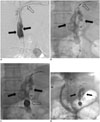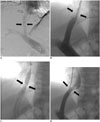Abstract
Objective
Materials and Methods
Results
Figures and Tables
 | Fig. 168-year-old woman with nonalcoholic steatohepatitis cirrhosis and recurrent gastric variceal bleeding.
A. Balloon-occluded venogram of gastro-renal shunt shows contrast filling of gastric varices (arrows) along with draining inferior phrenic collateral vein (open arrow). B. Inferior phrenic vein was embolized with microcoils (open arrow). This was followed by injection of sodium tetradecyl sulfate (Sotradecol; AngioDynamics) mixed with Lipiodol into gastric varices (arrows). C. It was not possible to leave occlusion balloon and sheath due to common femoral artery injury while obtaining femoral venous access. Therefore, gastrorenal shunt was embolized with multiple coils (open arrow) to retain sclerosant (arrows) in gastric varices before balloon was deflated and sheath was removed. D. Patient presented with hematemesis two days following procedure. TIPS was performed due to presumed gastric variceal bleeding. Venogram after TIPS placement showed no gastric varix filling from afferent veins and dense Lipiodol uptake (arrows) in gastric varices. Portosystemic gradient decreased from 15 mm Hg to 5 mm Hg. TIPS = transjugular intrahepatic portosystemic shunts
|
 | Fig. 2Flowchart summarizing re-bleeding after TIPS or BRTO in 52 patients.BRTO = balloon-occluded retrograde transvenous obliteration, GV = gastric varices, TIPS = transjugular intrahepatic portosystemic shunts
|
 | Fig. 347-year-old man with alcoholic liver cirrhosis with acute gastric variceal bleeding.
A. TIPS procedure was performed using 10 × 50 mm Viatorr stent (arrows) and 10 × 68 mm Wallstent (open arrows) extending to hepaticocaval junction. Portosystemic gradient decreased from 20 mm Hg to 8 mm Hg. Patient presented with recurrent gastric variceal bleeding two years later. B. TIPS venogram showed tight stenosis (arrows) at TIPS stent near hepaticocaval junction. C. Balloon angioplasty was performed at tight stenosis (arrows) near hepaticocaval junction. D. TIPS venogram after balloon angioplasty showed interval improvement of stenosis (arrows). Portosystemic gradient decreased from 15 mm Hg to 5 mm Hg. TIPS = transjugular intrahepatic portosystemic shunts
|
Table 1
Baseline Characteristics for Patients Who Underwent TIPS vs. BRTO for Isolated Gastric Varices

*Patient with hepatic C status post liver transplant and was thought to have drug related cirrhosis of allograft, †Numbers in parentheses represent standard deviation, ‡Some patients had multiple etiologies (i.e., hepatitis C + alcohol). BRTO = balloon-occluded retrograde transvenous obliteration, INR = international normalized ratio, MELD = Model for End-Stage Liver Disease, NASH = nonalcoholic steatohepatitis, TIPS = transjugular intrahepatic portosystemic shunts
Table 2
Comparing Outcomes of TIPS vs. BRTO for Isolated Gastric Varices

*Numbers in parentheses represent standard deviation. BRTO = balloon-occluded retrograde transvenous obliteration, GV = gastric varices, INR = international normalized ratio, labs = laboratory examinations, MELD = Model for End-Stage Liver Disease, TIPS = transjugular intrahepatic portosystemic shunts




 PDF
PDF ePub
ePub Citation
Citation Print
Print


 XML Download
XML Download